The 30th October 2019 is a crucial date for all English local authorities as it is the first date ever that they have to demonstrate that they have granted enough permissions for the 18,000 people that signed up to the Right to Build in its first year of existence. These are the people that signed their local self build registers, held by their council, to demonstrate that they were interested in building their own home.
The registers are a little complicated in how they work, but essentially the 30 October each year is a cut off point for when planning authorities need to show that they have acted. Each ‘base’ period works on a rolling three-year period – meaning that from the close of the first register year (the 30 October 2016) councils had three years to act. So the Right to Build Day is the first time we get to see how many plots have actually been granted permission to be built upon.
For the first year this figure was 18,000 – so on 30 October 2019 the authorities should (!) demonstrate that they have granted enough planning permissions to reflect this demand.
To find out what’s happening, the National Custom and Self Build Association (NaCSBA) conducts a Freedom of Information request to all English authorities, including county, borough and district councils and national parks. Its last request illustrated that, at October 2018, council’s Custom and Self Build activity across the country is very mixed, creating a postcode lottery of provision.
Right to Build Day will trigger the next piece of research. NaCSBA will be tracking activity, finding out the self build heroes and the ‘could-try-harder’ councils, and be sharing this information with you, the industry and, importantly, government in an attempt to get a more even spread of activity.
NaCSBA believes that Custom and Self Build gives more people more choice in the types of home, and what’s it can help encourage the build out of housing as it diversifies supply – an important goal for government as it works to get more 300,000 new homes a year by the mid 2020s.
Andrew Baddeley-Chappell, CEO, National Custom and Self Build Association said: “We’ve had to wait a long time since the legislation was passed to find out how effective it has been – and Right to Build Day will help clarify the picture. Our annual research and the work of the Right to Build Task Force has helped us to identify good, bad and some downright ugly performance from Local Authorities, and we will hold the government to its commitment to consider taking further action including possible changes to legislation if they do not believe sufficient action is being taken.
“Ongoing annual targets will mean local authorities will now need to continue to ensure a regular pipeline of new plots, enabling more wonderful new homes to be built and in doing so create a virtuous cycle of increased public awareness, increased opportunities and increased supply of custom and self build homes. The UK’s period at the bottom of the world league for the numbers of custom and self build homes may at last be coming to an end.”
*The ‘Right to Build’ places two legal obligations on Local Authorities in England:
1. Under the Self-build and Custom Housebuilding Act 2015 all Local Authorities in England must keep a register of people and groups of people who are seeking to purchase serviced plots of land in the authority’s area and to have regard to that register when carrying out their functions. Registers were required from 1st April 2016.
2. The Housing and Planning Act 2016 requires all Local Authorities in England to grant sufficient ‘development permissions’ to meet the demand for Custom and Self Build housing in their area, as established by their register, on a rolling basis. Permissions equivalent to the number of people registering from 1st April 2016 to 30th October 2016 should be granted by 30th October 2019. Permissions equivalent to the number of people registering from 30th October 2016 to 30th October 2017 should be granted by 30th October 2020 and so on. This includes 18,000 permissions by 30th October 2019.
There are many misconceptions about the registers:
The Right to Build registers are vital for alerting councils about demand – and they have to consider this. So by signing up you’re ensuring that more Custom and Self Build happens in your local area. And the more it happens, the more it becomes normal and accessible, with more people considering it as a route to a new home.
Images: pixabay
The Structural Timber Association has awarded Cullinan Studio the Custom and Self-Build Project of the Year category for its Push-Pull House in its Structural Timber Awards.
Run annually, Structural Timber Awards is a professional event that celebrates the best in timber frame technology, that includes a self-build category in acknowledgement of the sheer number of owner-commissioned homes that use timber frame as their construction method.
Timber frame is experiencing a boom as more and more organisation start to appreciate the benefits of offsite construction – where the entire building is precision made in a factory, ensuring efficiencies in time, quality and energy.
Cullinan Studio’s Push-Pull House is on a large plot in Amersham, in an area where the Arts and Crafts style dominates. The house is a playfully creative solution to the family’s brief to create a light-filled new-build, built using Cross Laminated Timber (CLT).
CLT uses layers of glued timber to create a strong and stable timber product, with the frame exposed throughout the interior. One of the advantages of CLT is that it is easily able to create long-spans, and the large house uses this to the maximum effect, creating uninterrupted roof spans and double-height walls that bring natural light deep inside the house, maximised by high clerestory windows. The exterior is clad in dark stained accoya boards that are fixed over a locally-sourced brick.

Judges’ comments included:
The head of the judging panel and Chief Executive of the Structural Timber Association, Andrew Carpenter said of the night: “The depth of expertise across all categories was impressive and the exceptional number of entries clearly demonstrates the upturn in the industry.”
For anyone considering a timber frame home, the Structural Timber Association has a self build section on its website offering advice, with links to finding members that operate in the realm of Custom and Self Build.
Crest Nicholson’s Tadpole Garden Village development on the edge of Swindon is set to have a selection of 14 serviced Custom Build plots, each with outline planning permission to build a bespoke home. Crest Nicholson has collaborated with self-build architectural and manufacturing experts Potton to deliver the homes on the site.
Potton have designed five Concept Homes that meet the Arts and Crafts Design Code of the village, with individual Plot Passports from which plot purchasers can take inspiration and appoint Potton to design their bespoke home.
Following the design process, the structure of the homes will be built by Potton, using high-performance timber build systems manufactured by them, with finishing works completed by the purchasers. This means that homes can be tailored to buyers’ budgets, needs and preferences, offering a more bespoke product, with homes expected to take less than 18 months from plot purchase to completion.
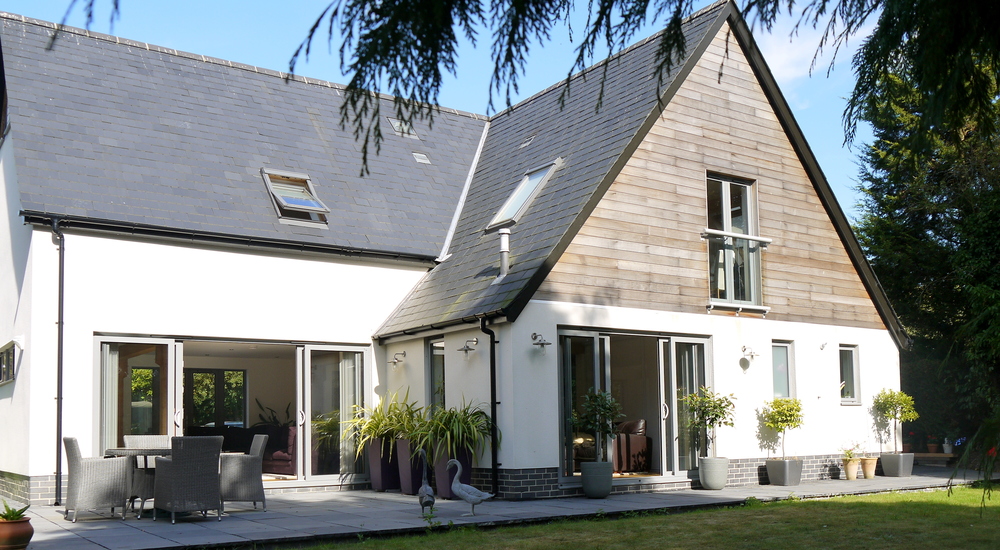
Tadpole Garden Village features a range of character areas spread across the development, with both contemporary and traditional homes set around award-winning public spaces, including a 60-acre Nature Park.
The concept is based on the original Garden Village principles of putting community at the heart of development, with shops, schools, parks and other facilities on hand, and an emphasis on community, as reflected through the community-hub website. In total, the site will have around 1,800 new homes, with a design code setting out the vision for the whole village.
Paul Newman, Self Build Director at Potton, said: “We are specialists in helping families create and construct their dream home. The biggest challenge that faces our customers is finding a plot of land to build on. We are delighted to be working with Crest Nicholson as they bring forward 14 plots in a prime location on a fantastic scheme.”
Andrew Dobson, Managing Director at Crest Nicholson Strategic Projects division, said: “We are pleased to partner with Potton to deliver this exciting range of custom build plots at Tadpole Garden Village. As a leading developer, we are always looking for innovative ways to respond to customer demands. Over time we have been seeing more demand for individual, bespoke homes that cater for the diverse range of people who live in our communities.
“These plots provide the opportunity for homebuyers to work closely with an architectural and developer team to design a home that is specific for their needs, both from a lifestyle and budget perspective. In addition, planning and infrastructure links for the homes are fast-tracked to ensure they can move into the community sooner.”
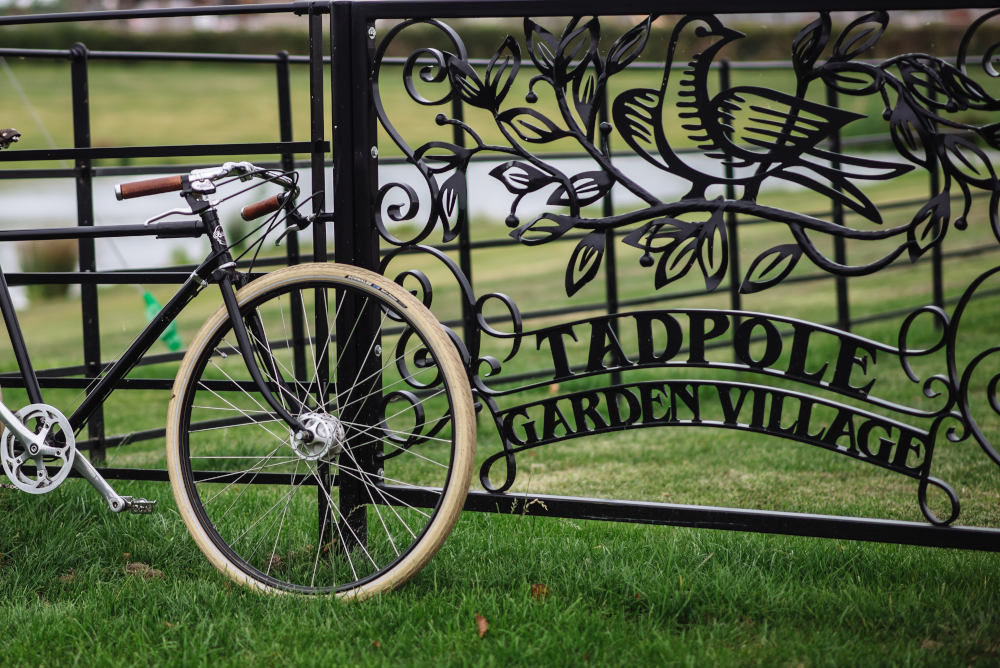
Anyone wanting to Self Build in Shropshire will want to keep an eye on Shrewsbury, where Shropshire Council is planning to bring on a 47 plot Self-Build site, off London Road.
Shropshire Council recently ratified a decision to invest in the infrastructure for the site, meaning that the development can now be submitted for planning permission. This will include full permission for infrastructure by the end of the year, enabling the roads, landscaping and services to be put in, together with outline permission for the individual plots.
It is expected that each plot will come with a Plot Passport, setting out boundary and height restriction on some of the plots, otherwise the individual will be able to design their own unique home.
The 4.41 hectare site has excellent links with Shrewsbury, and slopes down towards the River Severn making it an appealing location.
If things work out the council is hoping to bring the plots to market in 2020, with 37 Self Build plots, and 10 affordable-housing plots on offer.”
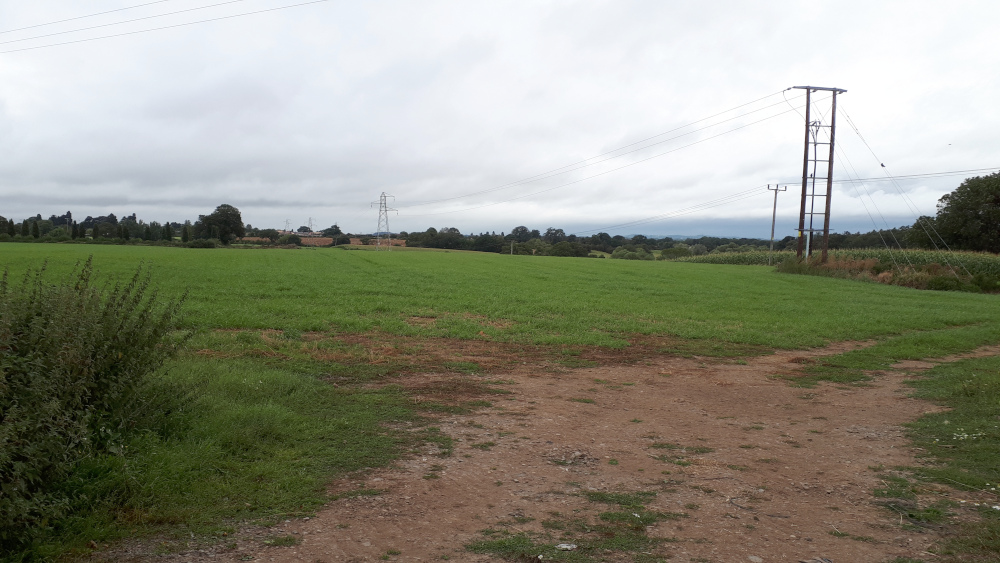
Shropshire currently has around 80 people on its Custom and Self Build Register, with around 500 from previous registers. Many of the people registered have identified Shrewsbury, pictured, as a desirable place to build, creating local demand.
Councillor Robert Macey, Shropshire Council’s cabinet member for housing and strategic planning, said: “This is a really exciting initiative. The London Road development will be an exemplar scheme, which is eagerly anticipated by other councils that are contemplating their own Self Build schemes. It’s the first-of-its-kind for Shropshire Council and is intended to showcase the potential for future self build developments.
“We’re aiming to provide a low-density Self Build, low-carbon, hybrid and unique development scheme for people that want to build their own homes and we hope this will provide a stepping stone to further Self Build plots in the future.
Shropshire County Council has an excellent reputation for working to help more people Self Build, both through bringing projects on, but also in the fact that it contacts people on its register with a quarterly newsletter sharing advice and information about upcoming sites.
The council also carries information about available plots on its website, and has an innovative single affordable plots policy for qualifying Self Builders. Together, this work led to it winning Best Council for Custom and Self Builders’ at the prestigious Build It Awards in 2018.
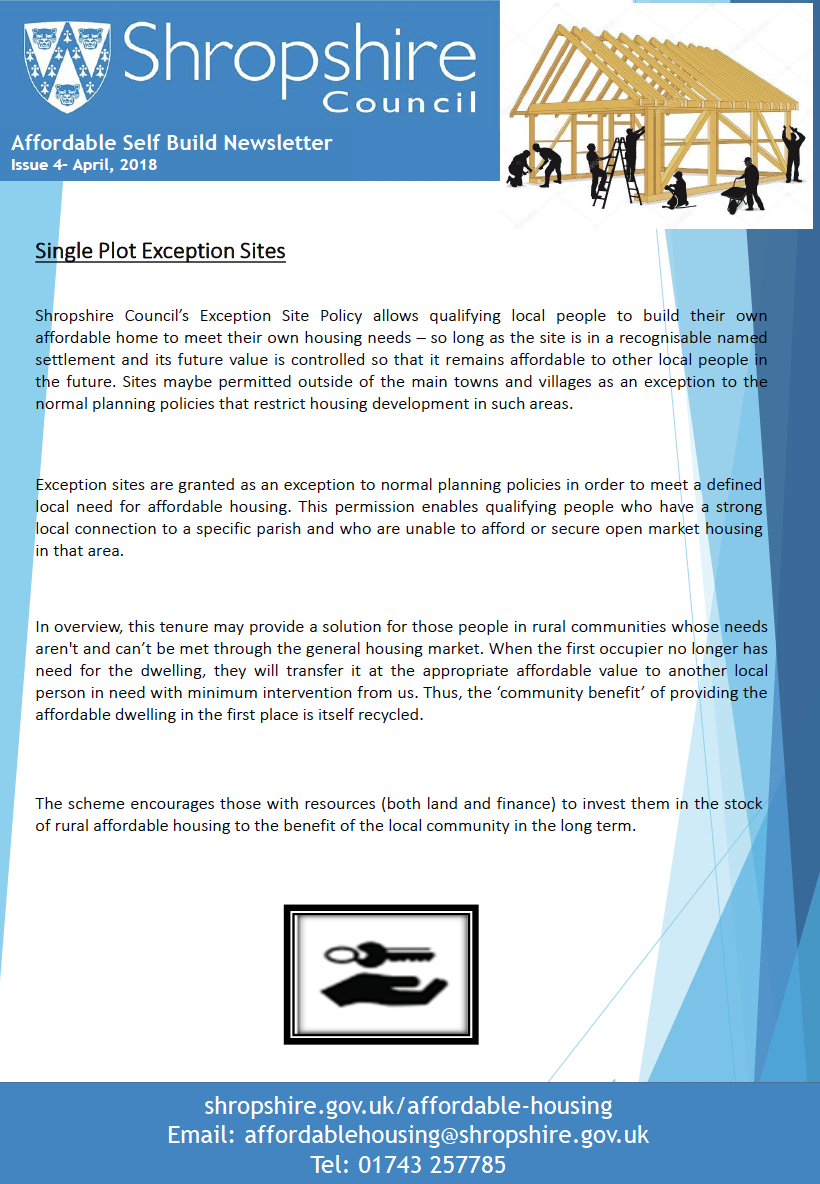
Anyone interested in the London Road site should sign up with Shropshire County Council’s Custom and Self Build register and keep an eye on the local press and the plots page on the council’s website. We hasten to add that by being on the register does not guarantee you a plot as demand is high.
Anyone interested in creating their own home through Self Build and Custom build should visit the National Self Build & Renovation Centre, the UK’s only permanent exhibition for everything Self Build. And to help spread the word the NSBRC has created its first ever TV ad, showing on All4 around homes-based programmes such as Grand Designs. What a reflection of a growing market!
National Self Build and Renovation Show takes place on 18-20 October and is the perfect time to visit the centre, whether your a first-timer or returning visitor. The three days of the show are packed with live demonstrations, seminars and a range of experts on hand to share their advice and insight, helping you make those important decisions about your own project.
Whether you are planning your build, or just putting together ideas for your dream project, the centre is a wealth of information, with the opportunity to find out more about a range of build methods and products. Or you can get 1-2-1 advice on a range of subjects from the in-house experts, or financial advice from BuildStore’s in-centre experts.
Tickets are free and parking is plentiful, with the centre located off the M4, near Swindon.
While most Custom and Self Build homes are not able to access Help to Buy, Graven Hill, the UK’s largest self and custom build development in Bicester, has enabled its purchasers to access the loan scheme for its Custom Build properties.
Help to Buy is available on all custom build homes at Graven Hill, such as the Eden home, shown, and the event is open to both first-time buyers and existing homeowners. Offering a practical route to making the dream of a tailored home a reality, Help to Buy allows buyers to apply for a 20 percent equity loan from the Government, meaning only a five percent cash deposit is needed, with the remainder covered by a 75 percent mortgage.
Karen Curtin, managing director at Graven Hill, said: “At Graven Hill, we are keen to create a community that is accessible to everyone. Help to Buy is a key part of this, ensuring that all our custom build homes are affordable, even to those taking their first steps onto the property ladder.
“Many people are still unsure of the benefits of the Help to Buy scheme, so this event will provide a brilliant opportunity to talk to industry experts, ask questions and find out everything you need to know about the scheme.
NaCSBA is aware that Help to Buy creates an unfair advantage for speculative house building, and is talking to Government about redressing this balance through the introduction of a Help to Build scheme.
If it were to go ahead, this enable more people to access finance to create their own Self and Custom Build home.
A new Customer Choice Centre has opened at Squirrel Wood, Design Your Home’s large custom build development in Hampshire, on a Homes England site. The centre includes a range of products, design solutions and options for people to choose from, giving them first hand experience of the choices on offer for their Custom and Self Build homes – a first for the UK. Customers can choose from a range of doors, skirtings, kitchens and bathrooms, as well as external cladding and bricks choices.
Situated just 10 minutes from Basingstoke, Phase 2 of Squirrel Wood is now on the market, offering Self Build, Custom Build or ‘Custom Choice’ opportunities, marketed through Custom Build Homes.
Starting from £260,000 for a Custom Build and £350,000 for a Custom Choice, the plots are part of the larger 122-plot site, where all planning is agreed in advance with Basingstoke Council for the range of design options on offer. This is pre-approval contributes to faster delivery, especially in comparison to going through the planning process individually, meaning homes can be delivered in a six month timeframe.
With its range of approaches, Squirrel Wood offers a vision for how customised homes can be delivered in the future, with customers have a series of choices to reflect their needs and circumstances, allowing them to balance choice with knowledge, time and budget.
Custom Build: At Squirrel Wood the Custom Build option gets you a fully-serviced plot with the choice of an internal layout from a wide range of pre-approved options. Once the plot is purchased customers enter into a contract with Design Your Home to build the property.
Using the Customer Choice Centre customers can select their internal and external preferences, giving them a truly personalised build, without the need for any construction knowledge.
Custom Choice: With the Custom Choice option the structure of the property is constructed prior to marketing, and customers have freedom to tailor the interiors. Unlike the Custom Build route, you pay for the property on completion, meaning you can choose a regular new build mortgage, or access the Help to Buy scheme. Custom-choice homes at Squirrel Wood can be completed within just four months.
Self Build: There are also a select number of Self Build plots on offer, with a Design Code establishing the rules around what is allowed in build terms.

New homes under construction at Squirrel Wood, with serviced plots laid out
For the custom options, there’s a range of house types to choose from, including 2-3 bed and 3-4 bed options, with further choices available depending on the plot type and route you choose.
Type A House: a 2-3 bedroom, terraced Custom Build home, with the option of a closed- or open-plan ground floor. Upstairs the space can be configured as two large bedrooms or three bedrooms with space for a study.
Type B House: a 2-3 bedroom, terraced Custom Build home with either a closed- or open-plan ground floor. Customers can have two large bedrooms, or three beds with an en-suite.
Type D Self Build Plot Only: a building plot with permission to build a detached 4 bedroom home. The Design Code sets the parameters of your design and, providing you satisfy these criteria, then you don’t need further planning consent.
Type F House: a 3-4 bedroom detached Custom Build or Choice home, with the choice of the kitchen at the front or the rear, and the option of an extra room with an extension. Again you can choose a two or three bed option upstairs.
The first custom homes on the site are now in their build phase, with first completions expected in the new year.
Kim Slowe, managing director of designyourhome.com said,“For far too long purchasers of new build homes in the UK have been given very little or no choice on both the layout and fitting out of their home. This makes little sense given that a home is likely to be the biggest purchase that an individual will ever make. designyourhome.com changes that. It gives homebuyers real choices whilst keeping the purchase and build process very simple. designyourhome.com has been designed to put the consumer in control for the very first time.”
Squirrel Wood is one of the Government’s original pilot scheme for innovative new Custom and Self Build housing, as set up by Homes England. The Homes England development is on the site of the Park Prewett hospital, with Design Your Home set up to bring Custom Build housing into the mainstream, as part of the vision of Places for People, the company behind it.
The National Custom and Self Build Association (NaCSBA) is running a survey of Self Builders who have reclaimed Value Added Tax (VAT) on their project. It is calling for anyone who has built or commissioned their own home in the last five years to fill in the survey, anonymously, as gathering this data helps it establish the size of the sector.
This data, together with other information, such as the number of single dwellings created per year, this gives us an estimate of the number of self builders in the country.
Knowing how many people are self building in the UK is vital for NaCSBA, as it shares these figures with the wider industry, and more importantly, with Government, helping fuel the conversation about creating more Custom and Self Build opportunities for more people across the UK. The more people that are building, the more new opportunities will come on the market.
From 2019 calculating the size of the sector will be easier, as there is now a question on the form that you must submit for planning permission (1APP), that will help gather this data. However, for earlier years we need to compile this data retrospectively – which you can help with.
Please help others who want to self build by filling in the survey, or by sharing it with friends and associates. If you have self built, custom built, commissioned a new home or converted a building into a home, then we want to know how you reclaimed your VAT.
The survey is anonymous – it’s just nine questions, but it makes a huge difference to the work we do as an organisation, helping us to make custom build and self build more of a mainstream choice for more people.
Thank you!
Image: DHayes
National Custom and Self Build Week ran from 6-12 May and was a huge success, helping more people access Custom and Self Build, and also flagging up the benefits and challenges of to Government. Here’s an overview of what went on.
At the invitation of Richard Bacon MP and Right to Build Task Force ambassador, NaCSBA held a reception at the House of Commons, bringing some if its members together to be addressed by Housing Minister Kit Malthouse and Kevin McCloud, as well as event sponsor Ecology Building Society.
There was a great atmosphere at the event, with Self Build, Custom Build and community-led housing celebrated, with commitments to do more and offer greater support for the sector from the highest levels.
Read more on NaCSBA’s news pages.
Finally, off the back of National Custom and Self Build Week, Victoria Prentis MP brought a Promoting Self Build debate to the House of Commons.
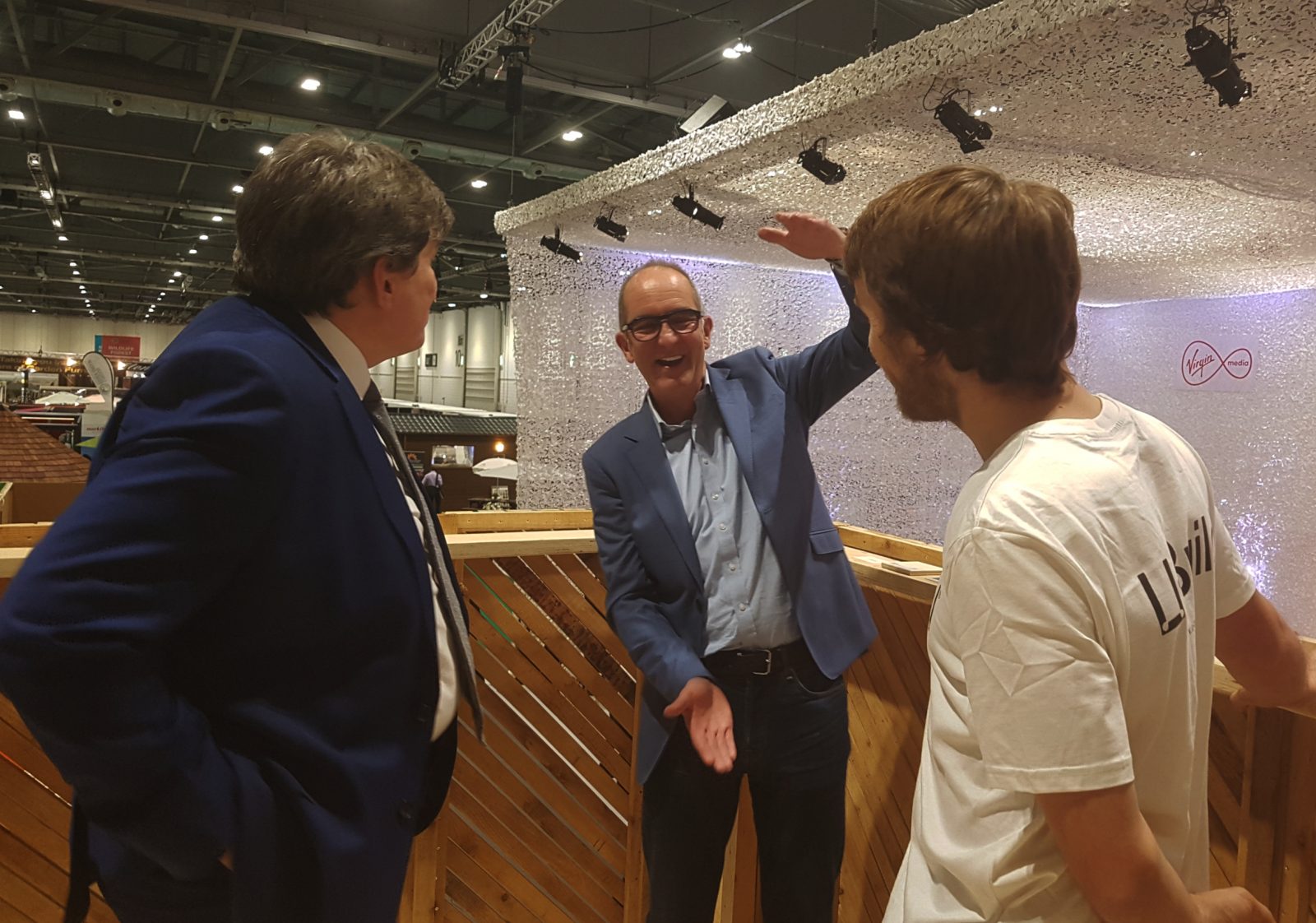
Self Build took centre stage at Grand Designs Live with NaCSBA on the main stage every weekday – to a packed auditorium eager to find out more about how, and where, to build. From the Right to Build registers to finance, NaCSBA’s team spent the week busting the myths that Self Build is Too Hard.
Plus our members joined the Ask the Experts team for the week helping dreamers and doers reach the next stage of their very own Grand Design project.
Also on stage over the week was NaCSBA member Graven Hill – home to the epic Grand Designs: The Street.
Incredibly, the Grand Theatre also saw Kunle Barker, Kevin McCloud and Kit Malthouse share the stage to discuss the benefits of Self Building!
Kit said: “This is National Custom and Self Build Week and we think self build and custom build has a huge potential to expand – other European countries do it much more than we do.”
#ThursdayThoughts: @Kevin_McCloud talks all the things @GrandDesigns The Street @gdlive_UK ahead of tonight's sixth and final episode tonight at 9pm on @Channel4 Read more about the episode here: https://t.co/Vg1IQw5m4d pic.twitter.com/HFwYAZyshH
— Grand Designs Mag (@granddesignsmag) May 9, 2019
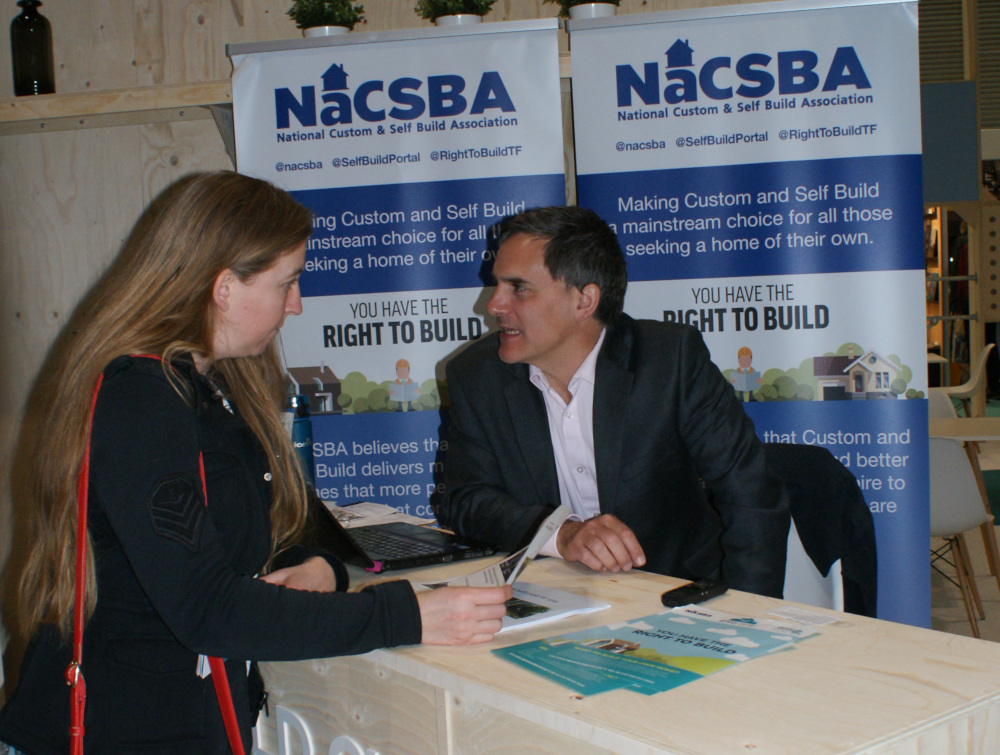
Custom and self-build homes are helping deliver the housing this country needs – a key part of reaching 300,000 a year by the mid-2020s. We’re supporting those who want to build these #MoreBetterFaster homes #SelfBuildWeek pic.twitter.com/5Ex2lGaeOx
— Ministry of Housing, Communities & Local Gov (@mhclg) May 10, 2019
Visitors to the Green Building Store’s Huddersfield Showroom got to find out more about the Right to Build and what it can – and can’t – deliver, while also finding more about the Green Building Store’s range of windows and MVHR systems.
The UK’s biggest Self Build Show Centre opened its doors and attendees to two of its Self Build Academy courses got an extra insight into the week and what it delivers.
The team at the National Self Build and Renovation Centre, the UK’s only permanent Self Build centre pulled out the stops with a discount for anyone signing up to its Self Build Course running through the week, as well as presenting on the Right to Build at the show, the following week.
Off the back of the week Self Build made the news with many papers covering the latest developments, not to mention The Street, including in the Metro, Sunday Times, Times and Financial Times.
NaCSBA would like to say a big thank you to the following companies.
Back in 2010 I went to The Netherlands on a trip (organised by NaCSBA) with a bunch of leaders of local councils and politicians to look at a large self-build town there, Almere, built on reclaimed land near Amsterdam.
The Dutch have always stolen a march on us in terms of housing initiatives. Now, Almere is full of self-built homes, but nine years ago it was already advancing, and I got so excited I had to go and see Channel 4, simply to say ‘it’s amazing what’s happening there, let’s film it’. It was a sort of self-build heaven.
Meanwhile, Cherwell District Council, a small local authority in Bicester, had also been bitten by the Almere bug. In fact, they wanted to replicate Almere and facilitate Britain’s first self-build and custom-build site on a grand scale. They were negotiating with the MOD to buy an old military site as they wanted to see what it would be like if they invited the general public to build their own homes.
It’s this experiment that we’ve been following for the last 5 years in Grand Designs: The Street. In the process, we’ve witnessed the first 10 pioneering households build a street of very different homes at Graven Hill.
But it’s just the start. Ultimately there will be thousands of homes, some social housing, some custom-build as well as self-build. I believe it’s a model that could be copied by local authorities up and down the land.
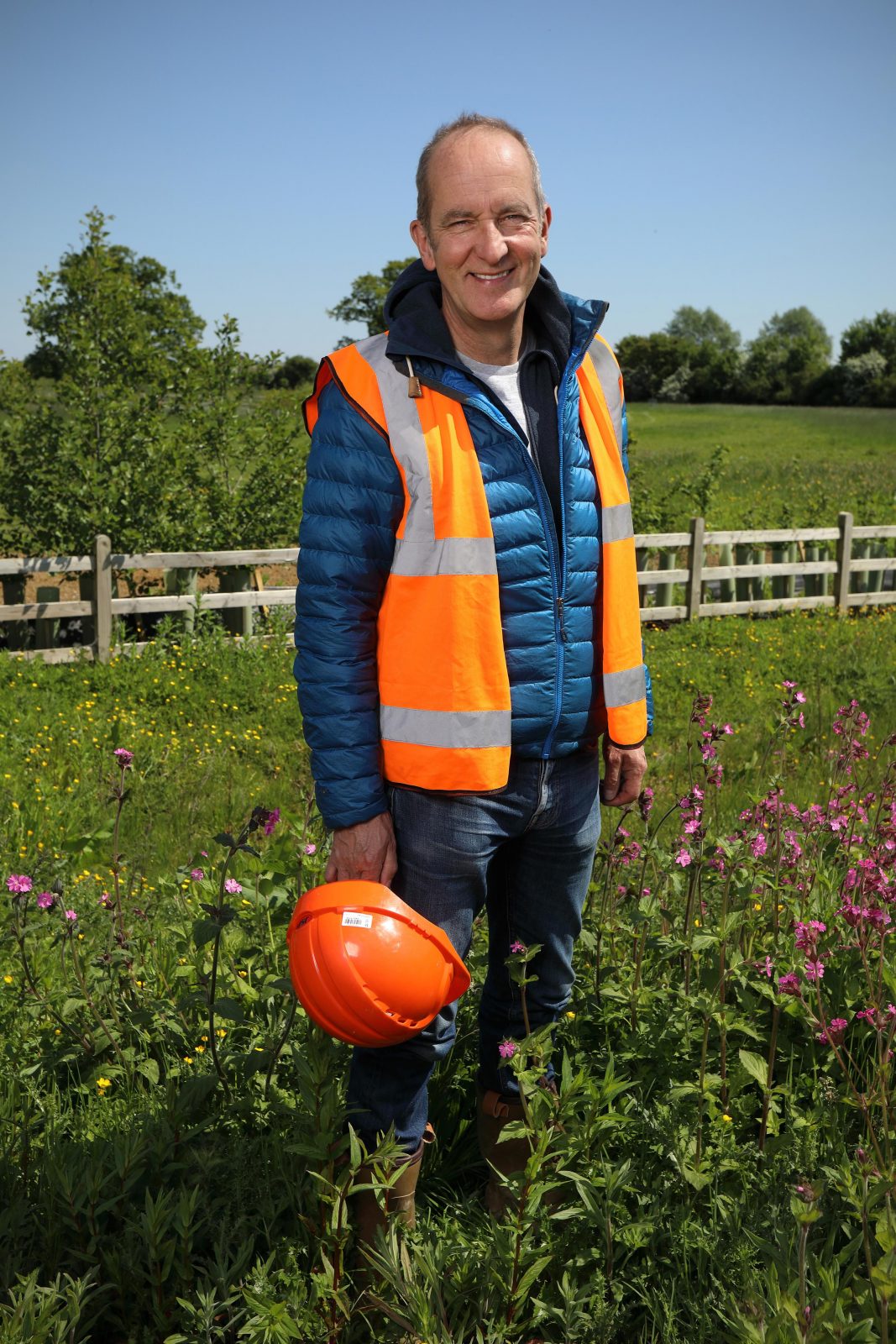
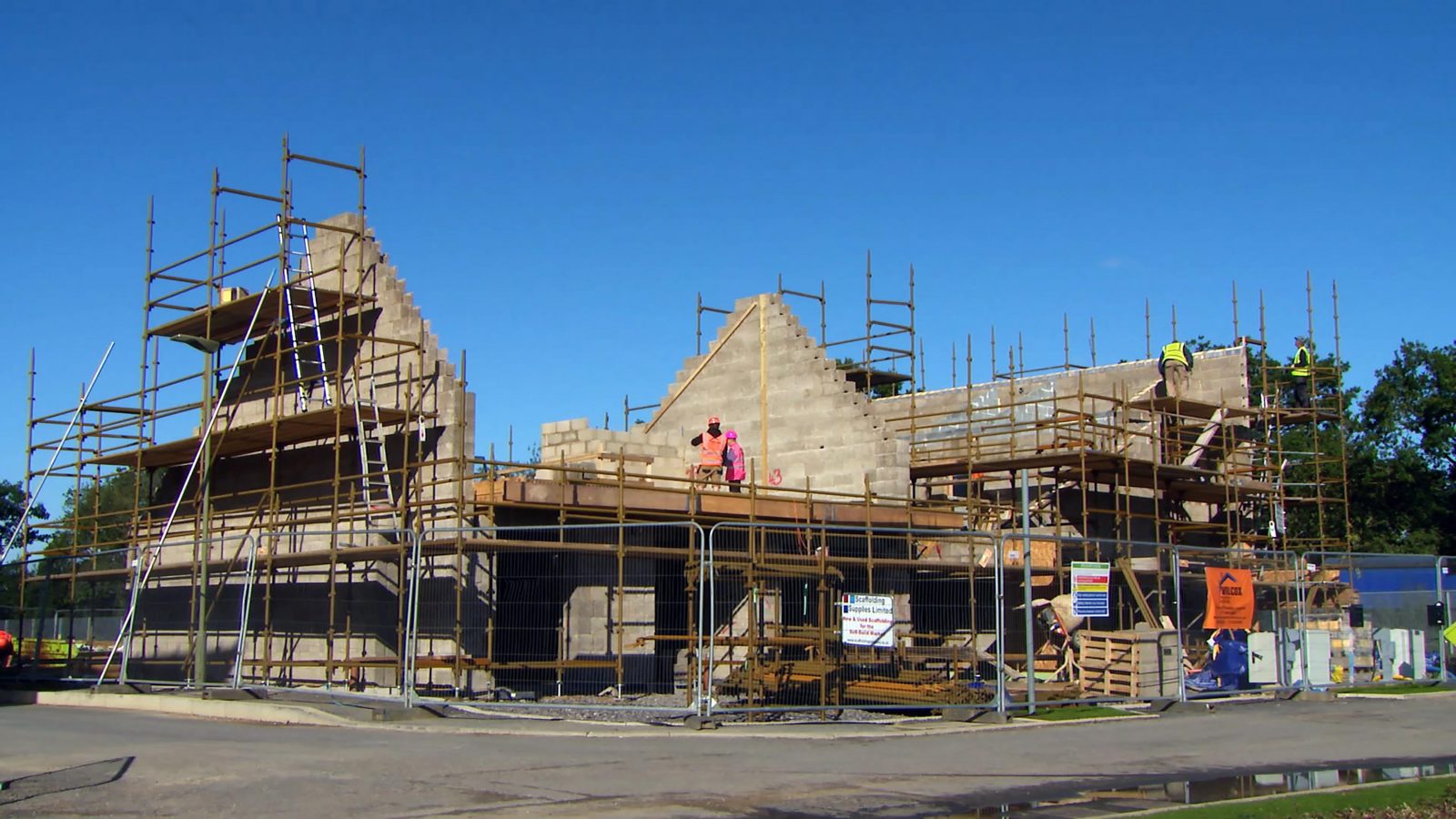
It’s very people based and very observational. We followed ten households, all of them from different walks of life, with different budgets and they’re probably at the lower end of what you would expect to see on Grand Designs.
These are more accessible projects costing anything from around £200,000 to £400,000, in terms of value, what they’re getting for their money is good architecture and homes that are really tailored to them – all with the lightest of planning!
Our pioneers are not people with large financial cushions to float on. Building for the first time brings with it a lot of financial, personal and emotional stress – which this series honestly reflects. Relationships get really tested and some fail.
I suppose we see a lot of that in Grand Designs, but goodness me I’ve never seen it so repeatedly and so intensely, as in this series.
These very different households all took a big risk but ultimately, I think they’ve been rewarded for this, with brilliant very individual homes and a great, wild-looking street – which is a sort-of test bed for self-build construction techniques, which I think is just brilliant. No two homes are the same.
I think two of the households stuck to budget, but self-build is a huge adventure in expression, in architecture, and in terms of discovering what it is that makes us happy and what we like from our environment. People talk about going over budget as if it’s this great cardinal sin, whereas, it usually results as a part of the process because people on the way discover things. On The Street one family wanted a dining room on the first floor, in another household Garrie alters the layout to better suit his wife Sue who’s disabled.
Sometimes building just takes you somewhere that’s far more exciting than you dreamt it would be. Peter and Anita and their teenagers Sam and Lucy, who [and self building]
gave them a larger kitchen, open plan living areas as well as cleverly designed spaces for individuals to retreat to do their own thing. Very important with teenagers – and unthinkable in their previous home.
They did all this and stuck to budget but towards the end of the project Peter realised, he could put an extra bedroom in the attic, and with their two kids it just seemed an obvious thing to do. Suddenly they were discovering what the process of design is. Financially their story was inspiring, the finished house ended up costing almost half as much as it would cost to buy something similar in the area.
It’s really hard for me to disassociate people and their stories from the building. For example, there’s the story of Lynn (pictured) and her house, which is sort of raw with problems. She experienced a great deal of bad luck and it’s very hard not to feel sorry for her, but she emerges in the series with a very beautiful building. It’s one of my favourite buildings, because it’s so eccentric.
The material, Hempcrete, isn’t common, but it’s certainly earned its pedigree in the UK. It’s a mixture of hemp, which is the stuff they use on the floor of equestrian arenas and is like finely chipped bark and lime. When mixed with water and lime it forms a kind of eco concrete, the texture of horse poo, which you stuff in-between shuttering. The entire house is built from this stuff – it’s highly insulating, structurally sound, has high thermal mass and locks carbon into a building.
Paul and Blanka slogged and crafted most of this house with their bare hands, occasionally with the help of friends and family. When things got really tough, the street lent a hand too, so it’s been very collaborative at times. It’s a house built from friendship really and has a very cool vibe about it. It’s also a beautifully crafted building and a house jam-packed with some very cutting-edge eco-gadgetry which I was fascinated by.
I think it’s because our relationships are defined in many ways, both emotionally and structurally. Relationships are sometimes defined with ambitions and dreams, and so to dream of a home together is a huge thing.
Some of the younger couples on the project have moving stories, for example Jack and Hannah, who worked so hard and lived with his Mum to save money on rent.
I think what you realise is just as the dream and the hope of that new home is so very strong it can be a very disconcerting experience when you’re living between houses, in a sort of limbo. It’s all a reminder of how home for us is a very powerful idea.
In terms of it being physically tough, Terry on plot 1 lost a huge amount of weight through self-building and overcame his diabetes. I saw Paul on plot 4 morph from a human rights lawyer into a builder and I witnessed Lynn, who’s 63, lugging huge blocks around on the hottest day of the year.
Although the planning process was streamlined, they still had to deal with the planners, local council, and building control. This is before they even started building. It was a long list. No one has ever said self-build is easy.
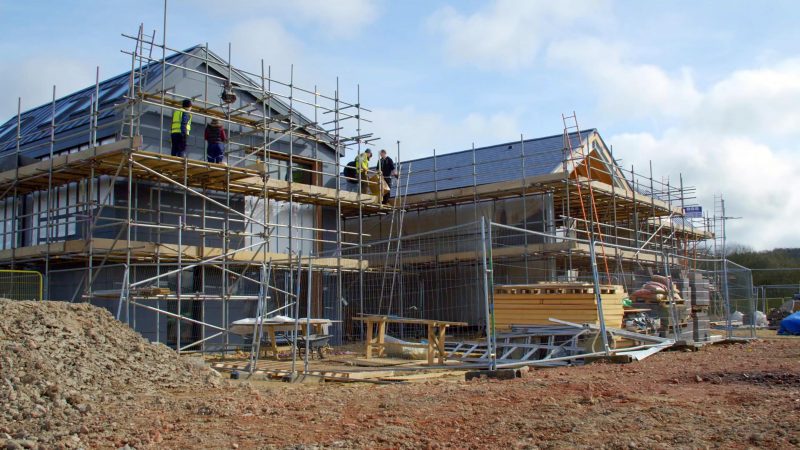
I once said to a self-builder, an artist: ‘you are extraordinary people for self-building’. She replied, correcting me: ‘no, we’re ordinary people just doing an extraordinary thing’.
It’s the idea that you take ordinary people who have got this slight glint of ambition and madness in their eye who say, ‘we can build a house, can’t we? How cool would that be?’ And before you know it, they’ve turned themselves into true radicals. I love that!
All of our pioneers – who started out as ordinary householders – have decided to build a home and they’re now all transformed as individuals and hugely empowered.
As this town of 1900 homes grows, they’re going to become the go-to gurus of how to build with Hempcrete, or how to deal with the mortgage company. They are the self-build wizards of Graven Hill, at once wise and magical.
I don’t always! I think for many people custom-build is a much safer route, which is where you work with an architect or developer who is building a house for you which is bespoke, but you’re removed from the day to day. However custom build can be more expensive.
Regardless, it’s always going to be stressful, it’s always going to be emotional, it’s always going to be harder than simply buying a home. Even buying a home isn’t that simple because all your hopes and dreams are invested in one idea, one transaction. It’s serious stuff.
The Pioneers all came with a mission to build a house for very personal reasons, but I was fascinated to see how well it all came together and how, in building a house, they could build a community, an astonishing achievement of which they should be proud.[the pioneers]

The thing that always surprises everybody is how long things take and what I’ve learnt in this series is there no such thing as an average or dull human being. Everyone has a story and usually a pretty fantastic one at that, and when we as a species are pushed out of our comfort zone, when the television is turned off and we are told to put our mobile phones down, all of us can rise to extraordinary levels of performance and adventure.
What I loved to see in this project was the transformation from a bare piece of brown field land next to a railway into a proper street and community. For the last five years the pioneers have slogged away, and they’ve got to know each other so well as a result, some have formed strong new friendships. It is sobering to think that they have spun all this invisible social glue; that this is just the beginning of something.
I think most people believe because they put up a shelf, they can build a house. Or because they have managed a marketing team, they can manage a team of builders, and that’s not always the case.
Better sometimes to be a good engaged helpful client who devotes time to thinking things through and making the thousands of necessary decision well. Better to have time to buy and bring the bacon sandwiches to site in the morning.
There’s a paradox right at the heart of building that explains why projects overrun and go over budget. It lies in the fact that people have ambitions, dreams and hopes; we’re not machines or spreadsheets.
We invest all our energies in the risk of one big idea which is both the most daring aspect of any project, and at the same time, the most glorious. We push and fight for the quality of that idea and that is what makes Grand Designs so watchable and compelling. It is the force that makes architecture happen.